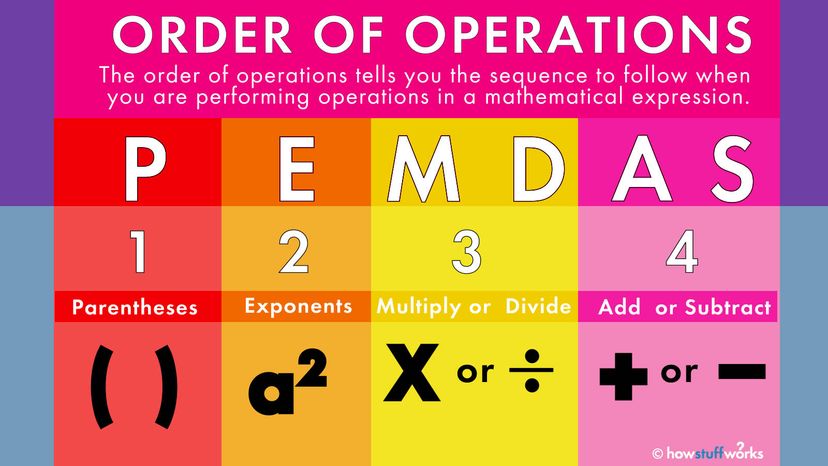Order of Operations Easy Way to Remember

They never told us what she did. Every middle school in the U.S. teaches its students to remember this simple phrase: "Please excuse my dear Aunt Sally." But why are we apologizing for her behavior? Did she wear white after Labor Day or something?
The world may never know. "Please excuse my dear Aunt Sally" is just a mnemonic. It's a tool educators use to help us memorize information through a catchy rhyme, phrase or acronym.
For another example, we turn to the realm of geography. If you can't remember the names of all five Great Lakes, just say "H.O.M.E.S." Each letter in that mnemonic acronym stands for one of the lakes in question: Huron, Ontario, Michigan, Erie and Superior. Nice and simple.
"Please excuse my dear Aunt Sally" is a math mnemonic. This time, the thing we're supposed to memorize is a critical concept called the algebraic order of operations.
Suppose it's finals week and you're expected to solve the following equation:
9 – (2 x 3) x 4 + 5 2 = ?
Don't panic. This is where a certain auntie comes in. For every word in the phrase "Please excuse my dear Aunt Sally," there's a corresponding math term which begins with the same letter:
- Parentheses
- Exponents
- Multiplication and Division
- Addition and Subtraction
Boys and girls, behold the order of operations! Also known as PEMDAS in the United States, it tells us which procedure(s) to perform first.
Before doing anything else, PEMDAS dictates that we ask ourselves a simple question: "Are there any parentheses?" If the answer is "yes," then our first move should be to resolve whatever's inside them.
So in the above example, we see "2 x 3" between two parentheses. Therefore, we'll begin by multiplying two times three, which gives us six. Now the equation looks like this:
9 – 6 x 4 + 5 2 = ?
Cool beans. Time to bring on the exponents! In print, exponents take the form of a little number pressed against the upper righthand corner of a larger number. See the 5 2 ? That itty-bitty "2" is an exponent, fella.
Here, the tiny two tells us to multiply five by itself. And 5 x 5 equals 25, giving us this:
9 – 6 x 4 + 25 = ?
What's next? Glad you asked. Having taken care of the parentheses and exponent(s), we shall now proceed to those next two operations: multiplication and division.
It's important to note that we're not saying multiplication comes before division here. Not necessarily, at least. Let's say you're looking at a different problem which — at this stage — contains both a multiplication sign and a division symbol. Your job would be to perform the two operations in order from left to right.
The concept is best explained by way of example. If the equation reads 8 ÷ 4 x 3, first you'd divide the eight by the four, giving you two. Then — and only then — you would multiply that two by three.
We now return to our regularly scheduled math problem:
9 – 6 x 4 + 25 = ?
Whoever wrote the original equation kept things nice and simple; there's nary a division sign in sight and only one multiplication symbol. Thank you, merciful exam gods.
Without further ado, we're going to multiply the six by the four, giving us 24.
9 – 24 + 25 = ?
As with multiplication and division, addition and subtraction are part of the same step. Once again, we're performing these two operations in order from left to right. So we're going to have to subtract that 24 from the nine.
Doing so will give us a negative number, specifically -15.
BUT the 25 is a positive number. So in its current form, the equation consists of a negative 15 plus a positive 25. And when you add those two together, you get a positive 10.
So there it is. The answer to our riddle.
9 – (2 x 3) x 4 + 5 2 = 10
Before we part ways, there are a few more things you should know. You may someday find yourself looking at a complex equation with lots of different operations sandwiched between two parentheses. Maybe something like this:
9 – (2 3 x 3 ÷ 18) x 4 + 5 2 = ?
Don't sweat it. All you've got to do is go through the PEMDAS process inside those parentheses before you move on to the rest of the problem. Here, you'd take care of the exponent first (i.e., the 23), then handle the multiplication/division. Easy-peasy. (In case you're interested, the answer to the equation is 28 2/3, or 28.67 if you prefer decimals.)
Finally, you might be interested to learn that the order of operations — as Americans know it today — was probably formalized in either the late 18th or early 20th century. This coincided with the rise of the U.S. textbook industry.
In an email, math and science historian Judith Grabiner explains that concepts like the order of operations are best thought of as "conventions, like red-means-stop and green-means-go, not mathematical truths."
"But once the convention is established," she says, "the analogy to traffic lights holds: Everybody's got to do it the same way and the 'same way' has to be 100 percent unambiguous." Math and ambiguity are uncomfortable bedfellows.
Other countries have their own acronyms, though. In certain parts of the world, children are taught to remember "BODMAS" — Brackets; Orders (i.e., exponents and square roots); Division and Multiplication; Addition and Subtraction — instead of "PEMDAS."
Originally Published: Dec 16, 2020
Source: https://science.howstuffworks.com/math-concepts/PEMDAS.htm
0 Response to "Order of Operations Easy Way to Remember"
Postar um comentário